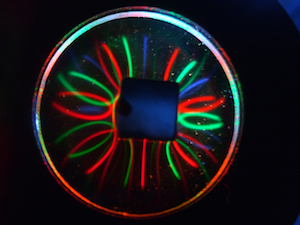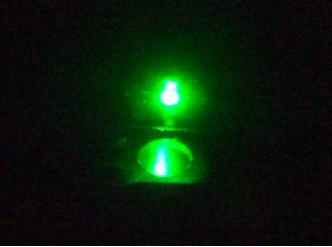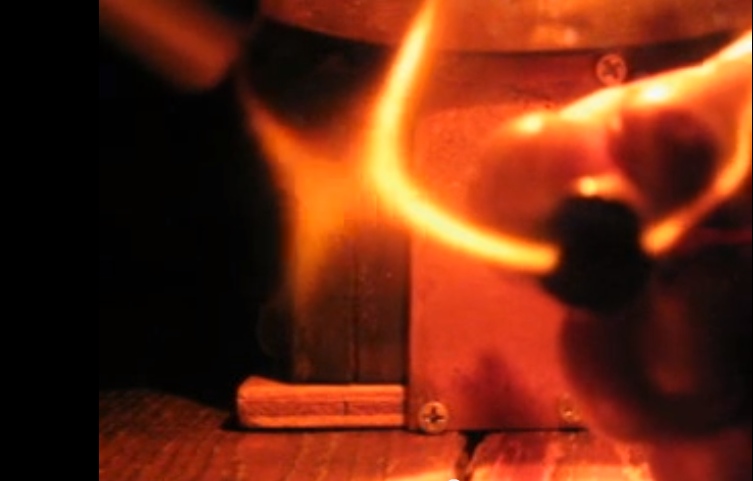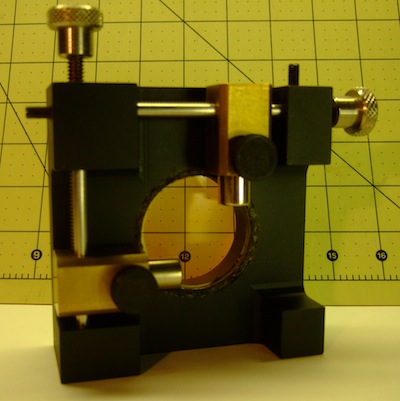
Introducing Ferrocell® Technology
|
The Ferrocell's methodology is based on transforming a black, opaque
liquid metal (ferrofluid) into a dispersed, transparent layer less than 15 microns thick. This nano-fluidic thin-film is contained in a sealed and isolated environment. In this state, the fluid behaves more like a dense gas than a liquid (see References) and functions like a long pass optical filter for visible light. When influenced by a magnetic or electromagnetic field, the nanoparticles form into microscopic (~10-200 µ) chains and change their state from superparamagnetic to ferrimagnetic. This dynamic process continues as the particle chains travel (via Lorentz force) from the south magnetic pole
to the north pole in a path determined by the polar coordinates of the applied field which results in an optical rotatory dispersion of the light from the self-assembling
meta-surface and into a visible ellipse to the observer.
|
|
Small incandescent lamp below Ferrocell
with cylinder magnet centered on cell.
A multitude of magneto-optical effects are present
The center point between poles of the viewed image represents the magnetic
Null Zone or more generally, the Domain Wall of a ferrimagnetic material.
The lines we see using a Ferrocell can best be described as isopotential
and not field lines (B) like iron filings or FEMM software show.
Each path of light is a result of the curvature and polarity of the applied
magnetic field and it's polar location around the cell's circumference.
Ferrocell and Iron Filings Overlay*
Notice the "field lines" are 90 degrees offset from the "iso lines".
Black areas are magnetic poles (N&S)
What we see will change its 3-D geometric shape depending on our point
of view in direct relation to the light source and orientation of the
applied field. If one factors in the time required for the image to appear,
we are viewing a 4-D event. According to A. Einstein,
-
These shimmering paths can be twisted, bent, made thicker or thinner,
joined or repelled, added to or subtracted from by the polar
influence of two or more magnetic fields or one magnet and a nearby ferrous metal.
Other materials will react depending on their magnetic properties,
but with a weaker display than ferrous materials.
-
Unlike most passive optical devices, a Ferrocell will exhibit the
same visual results with polarized or non-polarized light.
Use of laser and parallel magnetic fields will result in
lensing effects, which can be useful in creating "flat"
lenses that mimic typical curved glass optical lenses.
Example of electromagnetic lensing effect
the Quantum realm and Nanotechnology without the mess, cost or build-time.
Ferrocells have a 2 year warranty against defects (except scratches).
-
Light experiences Birefringence, Rayleigh & Mie light scattering,
the Kerr Effect,the Faraday Effect and other Magneto-optic
phenomenon using a Ferrocell with an applied magnetic field.
-
For more detailed information, see: the References page
*Overlay image provided by Emmanouil Markoulakis |
 |
Ring of 15 RGB Led's under and around cell. 12.7mm cube magnet setting on glass. Each isopotential band converges on the magnets poles (bottom and top). We see two bands from each Led as the isopotentials extend to each pole. |
|
1.2 Tesla cube magnet wrapped in black tape with small square of black tape on top (to reduce reflections).
Magnet pole is resting on rear side of Ferrocell and back-lit with white halogen light. Front of cell shows light following along the field's isopotential or null zone. Lighter, wider arc over top of tape is a result of scattering in a perpendicular direction. See a motion demonstration of this effect below. |
|
|
If you can't play this on your computer,
click here to watch on Youtube
|
Take a look at this movie and pause at 6 sec. This is a location where a red laser beam scatters around the isopotential of a cube magnets field ('ring') and where the laser diverges into opposite directions ('rays'). These rays are actually an ellipse that extends away from the cell surface. This projected ellipse grows exponentially larger as the distance from cell to screen increases. In this effect, the cell functions as a magnetic lens. By applying a magnetic field (or electromagnetic) in a predetermined polarization, the light may be rotated or positioned at a movable point. |
 |
This is a 1400x image has been altered only by using a green filter in
Photoshop. The nano-particles have assembled into microscopic dual chains, oriented perpendicular to the applied magnetic field.
This region is where the ellipse emerges. A laser shining through these
chains scatter into opposite directions forming an x-axis ray.
This condition of the particles moving into a lower energy state is known as the Rosensweig Instability. |
|
A paper parabola target is placed on the output side of a Ferrocell
induced with two cylinder magnets and stimulated with a red laser. Top two frames show target without (L) and with (R) magnets.
With magnets, a ellipse forms on the target. It's obvious the arc of the ellipse has diverged a full 180 degrees.
(look closely at the lower left and right frames).
Light emerges and diverges into the X-axis arc from the center of the cell with the same diameter as the primary Z-axis laser beam,
but at a reduced brightness. A significant amount of the laser beam
is wasted in the primary Z-axis, but can be useful by using a
variety of modulation methods for extended modes of operation.
|
|
 |
By inducing a 4-phase (with 90 degree offsets) quadrupole electromagnetic field into the cells center, the arc can be rotated continuously in a 360 degree circle around the laser beam (helical). |
A Different type of Technology:
A Ferrocell responds to an induced magnetic field and is capable of scattering light with additional
degrees of freedom than neither MEMS or FLCD technology can obtain.
 Home |
 Pics & Movies |
 Products |
Support |